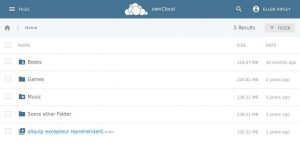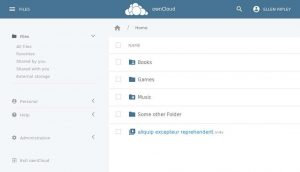ownCloud Unveils Phoenix New User Interface
Redesigned front end into software
This is a Press Release edited by StorageNewsletter.com on April 6, 2018 at 2:04 pmWith Phoenix, ownCloud GmbH integrates a redesigned front end into its software.

In the future, the interface should only contain HTML, JavaScript and CSS files and be completely independent from the server. This WebUI creates a clearer and easier to understand code structure. The modular setup results in a design pattern that can be used without further modifications of the CSS files.
Click to enlarge
The decision for the complete relaunch was mainly based on technical considerations. The company’s solution front end has undergone continuous development in recent years – both in terms of user experience and from a technical perspective. In this way, a large number of parallel JavaScript libraries, frameworks and components were created, which made the existing front end increasingly complex but also confusing.
The developers then looked for a way to write HTML templates, decouple them from the data model and thereby obtain a clean and understandable structure for writing code. Phoenix makes a cut here and delivers a redesigned interface based on the latest front end technologies such as WebPack, Vue.js or UIKit.
An innovation is the modular structure (UIKit), which provides for a so-called ‘atomic design pattern’ that can be implemented and further developed without programming effort.
Click to enlarge
Liberation of front end
With the relaunch, the front end is completely separated from the ownCloud server. Phoenix is a pure web client that only contains HTML, JavaScript and CSS files and only communicates with the server via public APIs such as WebDAV or OCS Share.
The foundation stone for Phoenix was laid in 2017 as part of the Google Summer Of Code. The community developer Noveen Sachdeva implemented the js-owncloud-client library and the corresponding feature to enable cross-domain requests to the ownCloud server.
The integration of Cross-Origin Resource Sharing (CORS) enables any website to access its ownCloud in a controlled manner via APIs. The prototype for Phoenix comes from Felix Heidecke. (profile on GitHub)
From a deployment perspective, Phoenix runs in an isolated environment and can be hosted on a separate web server. Operation as a consolidated application within the same web server, which also provides the ownCloud back end, is also possible.
The first version of Phoenix is aimed primarily at larger and clustered installations where the operators of ownCloud want more control over resource usage and network topology. Phoenix is installed and updated via the ownCloud Marketplace and is ready for use after installation.
Phoenix is currently in the test phase and will soon be available parallel to the existing front end via the ownCloud Marketplace. The next development step will then take place within the framework of the Google Summer of Code. The selection of the students and the determination of the concrete topics for the well-known programming scholarship is carried out by ownCloud in cooperation with the partners CERN and AARNet.
This is followed by the release of the app plug-in and the search for the first candidates for the test phase. Phoenix is open source and as a community project open to all who want to contribute. Interested developers can participate via the Phoenix channel on ownCloud Talk or in the corresponding GitHub thread.
















 Subscribe to our free daily newsletter
Subscribe to our free daily newsletter

